Deployments - Pearl Harbor |
| |
 |
| |
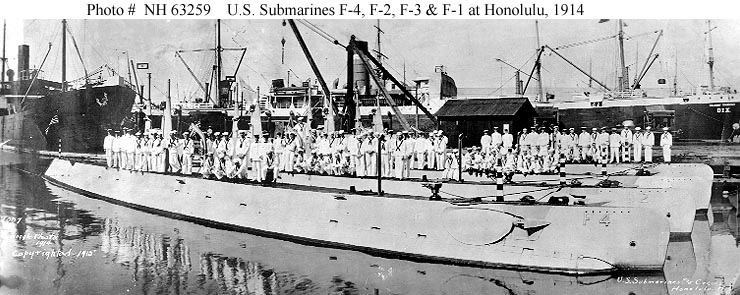 |
| There were really three attempts at establishing a submarine base at Hawaii. The first was between 1914 and 1915 during which time four "F" class submarines operated from the old Naval Stations Pier 5 in Honolulu. However - when F-4 sank off Honolulu - the other three submarines were towed back to the west coast. |
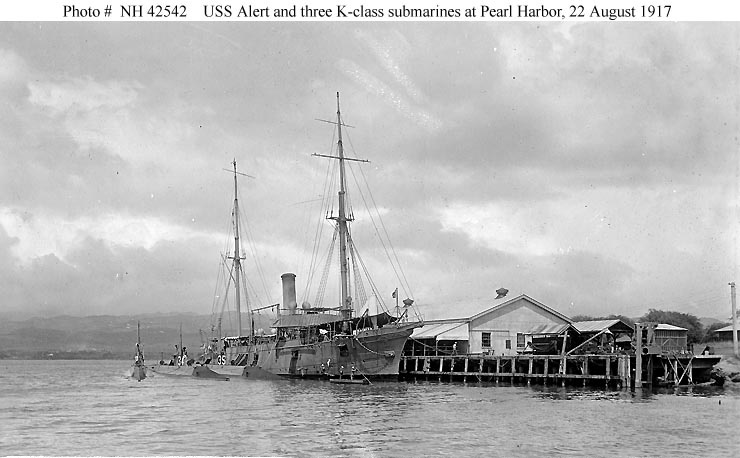 | USS Alert. (AS 4) moored at the wharf at Kuahua Island on 22 August 1917. K-3 (Submarine No. 34) and K-4 (Submarine No. 35) are identifiable alongside; the unidentified "boat" is probably either K-7 (Submarine No. 38) or K-8 (Submarine No. 39). |
| In 1915 USS Alert (AS 4) was deployed to Hawaii with four K class submairines (K3, K4, K7 and K8) - which operated in the local waters until approximately 31 October 1917. When the War in Europe broke out - the Navy decided to pull it's assets close to home - so Alert and the four K class submarines in her charge were ordered back to the West Coast. As nothing permanent had been built - when the tender weighed anchor- the "submarine base" went with it. |
| Finally in 1919 submarine Division Fourteen was formed - and ordered deployed to Hawaii. The first six submarines R-15 to R-20 arrived 25 June and when they arrived - they found like so many other submariners before them - they were left pretty much fending for themselves. The "facilities" they were "given" consisted of a single finger pier in an area of Pearl Harbor that was isolated, covered with cactus plants and algaroba trees and little else - save one ship - USS Monterey - which had been towed to Pearl Harbor from Cavite by the Collier Ajax two years prior.For the time being - Monterey became the division's tender. In December - the "assigned" tender for the division- USS Chicago - finally arrived with orders to extablish a permanent base - and aboard was the man to accomplish that job - Lt. Commander Nimitz. Ten more "R" class boats - R-1 - R-10 arrived in 1923 - by which time many permanent buildings were well along under construction - and the facility began taking shape - some of which still exists today. |
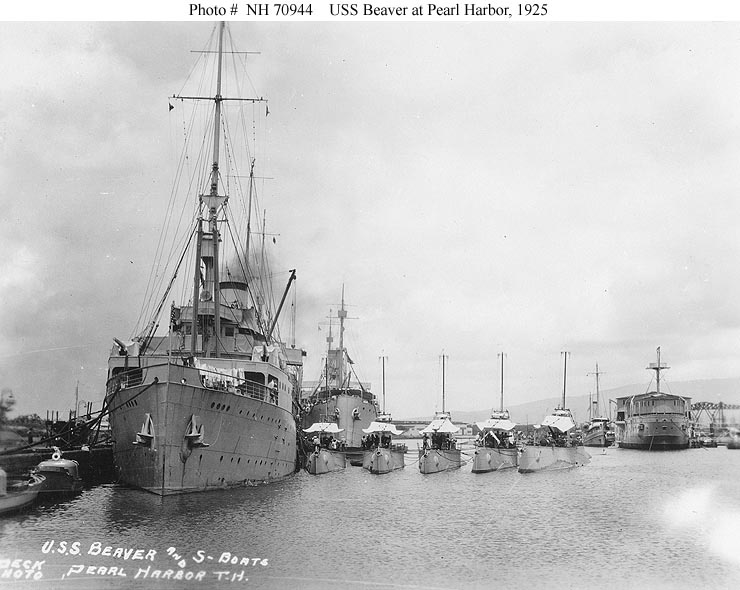 |
| USS Beaver (AS 5) at Pearl Harbor in 1925, with five "S-Type" submarines alongside. The old protected cruiser Chicago is in the right background. The construction on her decks to provide additional spaces for berthing, etc. can be clearly seen. | |
| As the 1920s passed into the 1930s - many of the temporary buildings were replaced with modern facilities purpose built for specific use. Two more finger piers were also built. In 1928, the largest building of the era - the "U" shaped barracks building was completed - and had sufficient capacity such that no additional space was needed until just before World War II. By 1933, berths 10 to 14 on a long quay wall had been completed and a thirty ton crane had been constructed on the outboard end of finger pier number four. Other facilities completed at the time were the submarine rescue and training tank, the enlisted men's pool, the theater (built entirely by submarine base personnel), and the main repair buildings. The Administration Building, housing the base torpedo shop in the main deck of one wing and the Supply Department on both decks of the other wing had also been completed. Above the torpedo shop, was located the Base Commanding Officer's and Executive officer's offices. Shortly after the completion of this building, an officer's quarters was built close to the Administration Building. Since there was now housing and messing facilities for both officers and enlisted men, Chicago was no longer needed. During these years - Chicago had served as Division Tender (1919 - 1923); decommissioned and assigned as barracks ship to the Submarine Base (30 September 1923 - 1935); been renamed Alton (16 July 1928 - at which time she was redesignated IX-5); and finally sold May 13, 1936. She foundered while being towed accross the Padific and was lost in July 1936. In addition to the building boom at the base - the mid 1930s through early 1940s also saw the planting of a great deal of landscaping - making the Submarine Base not only a productive environment - but a pleasant place to work and live as well. |
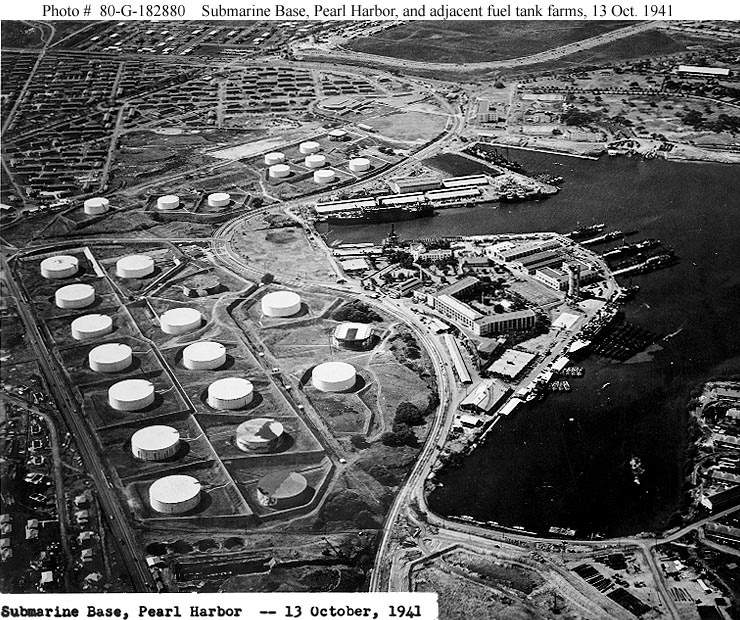 |
Aerial view of the Submarine Base with the fuel farm at left, looking south on 13 October 1941. Among the 16 fuel tanks in the lower group and ten tanks in the upper group are two that have been painted to resemble buildings (topmost tank in upper group, and rightmost tank in lower group). Other tanks appear to be painted to look like terrain features. Alongside the wharf in right center are USS Niagara (PG-52) with seven or eight PT boats alongside (nearest to camera), and USS Holland (AS-3) with seven submarines alongside. About six more submarines are at the piers at the head of the Submarine Base peninsula. | |
| On 30 June 1940, there were 359 enlisted men stationed at the Submarine Base with this number slowly increasing to 700 on 15 August 1941 and to 1,081 in July 1942. Rapid expansion of the base reached its peak in July 1944, when there were 6,633 enlisted men serving on the Submarine Base proper. These were the men for whom there was no glory but who, nevertheless, worked excessive hours no matter what their job in order that our submersibles might roam the Pacific in excellent fighting condition. Fortunately for America, and conversely, unfortunately for Japan, the enemy neglected to strike at Pearl Harbor Submarine Base on 7 December 1941. Quite possibly this could have been by design since the Japs conceivably paid little attention to the comparatively small submarine force the United States had operating in the Pacific, the majority of which, incidentally, was operating in the Far East. But for whatever reason, no damage was done to the base and for this oversight the Japs were to pay dearly since it was the submarine force in the Pacific that, almost alone, carried the war into the enemy's waters in the first two years of the war. The following is from an official summary of Submarine Base Pearl Harbor war time efforts: As an indication of the tremendous amount of work accomplished by the Pearl Harbor base, four hundred submarines were overhauled, refitted, or repaired during the period from May 1944 until July 1945. (This should not be construed as 400 individual submarines, but rather as a certain number of subs overhauled numerous times). This meant four hundred submarines prowling the seas, destroying Japanese shipping relentlessly through the sole medium of repair and supply furnished by one base. Truly, the enemy missed a military objective by blindly overlooking the Submarine Base on the day of the "blitz".This wartime record is indeed impressive - however - while the writer's enthusiasm is commendable - we must note that the writer fails to mention that during the war - as many as four tenders were deployed and active at Submarine Base Peal Harbor contributing to this record - and in fact - the workload was so heavy that at times tenders in transit to other deployments would spend a month or so helping to catch up on the workload (note the one month stays of Fulton (on her way to Midway), Sperry (on her way to Guam, providing refit for one submarine and voyage repairs to three others), Griffin (on her way to Fremantle) and Orion (only one submarine at Pearl on her way to Australia). It's clear that tenders made a huge contribution to the effort at Pearl Harbor. |
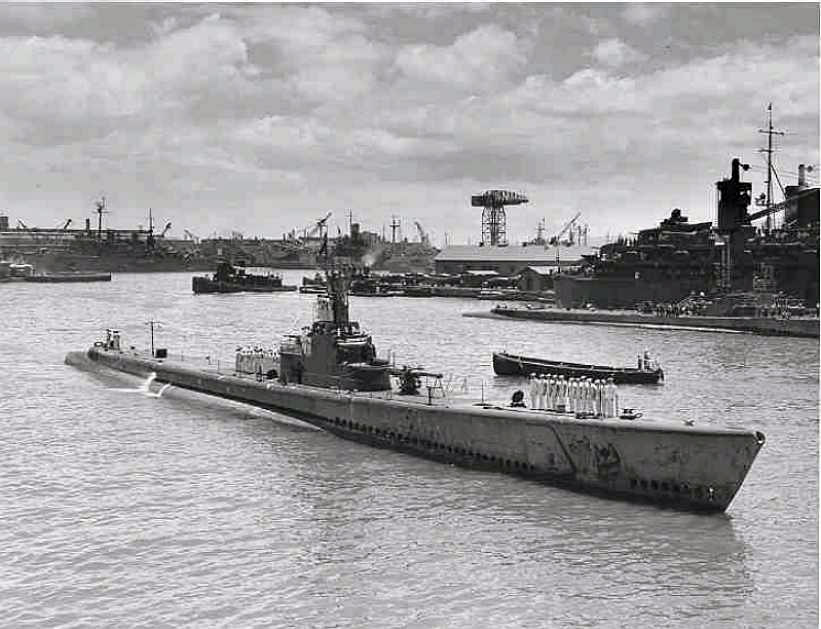 |
| Notice the Fulton class tender in the background behind this boat returning to Pearl Harbor druing WWII |
| |
| After the war - USS Bushnell (AS 15) was deployed as station tender at Submarine Base Pearl harbor - where she served for just over a year. Once she left - Submarine Base Pearl Harbor did not have the services of a tender save for a very short time during the height of the Korean War (USS Sperry AS 12) and a sixth months deployment by USS McKee AS 41 in January 1998 through July 1998. |
| Go Back to Deployments - San Pedro | Continue on to Deployments - San Diego |
| Return to TenderTale Main Page © 2006 Common Cents Computers | |